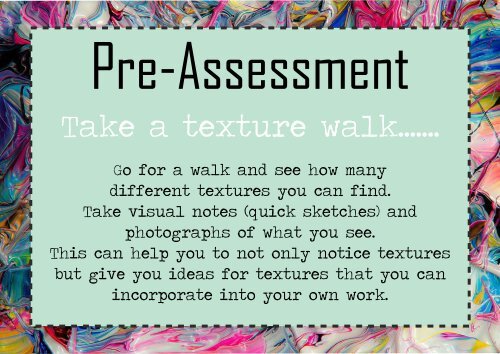Year 7 TEXTURE Art Project FINAL
Create successful ePaper yourself
Turn your PDF publications into a flip-book with our unique Google optimized e-Paper software.
Pre-Assessment<br />
Take a texture walk.......<br />
Go for a walk and see how many<br />
different textures you can find.<br />
Take visual notes (quick sketches) and<br />
photographs of what you see.<br />
This can help you to not only notice textures<br />
but give you ideas for textures that you can<br />
incorporate into your own work.
Assessment Objectives<br />
1. Examine what the word texture means in art.<br />
2. Analyse how artists use texture in their artwork.<br />
3. Evaluate and apply a range of textures to create<br />
your own 2 dimensional art piece.<br />
Next steps....<br />
Here are some useful steps to get help you come up with effective ideas.<br />
1. Find out what texture is....<br />
2. Find out about artists who use texture<br />
3. Brainstorm your ideas.<br />
4. Experiment with a range of media<br />
5. Get lots of resources, take a look at the books available and video clips.
Look at both types of texture and<br />
how they are used by artists.<br />
Does everything have a texture?<br />
How do I draw it?<br />
What’s the best media to use?<br />
What media haven’t you tried yet?<br />
Top Tips
<strong>TEXTURE</strong> is the character of a<br />
surface and is both tactile and visual.<br />
Tactile texture is the tactile quality of a surface, such as rough,<br />
smooth, sticky, fuzzy, soft or slick. A real texture is one you can<br />
actually feel with your hand, such as a piece of sandpaper, a wet<br />
glass, or animal fur. It also can be created by an artist by doing a collage.<br />
Visual texture is a visual quality of a surface. It is the result from painting or<br />
drawing as the real texture. Visual texture is an illusion of texture created by an artist.<br />
Paint can be manipulated to give the impression of texture, while the paper surface<br />
remains smooth and flat.
<strong>Art</strong>ists<br />
Here are some artists who use<br />
texture in different ways.....<br />
Can you work out how they do it?<br />
Maggie Ayres<br />
Maggi Hambling
Fenella Elms<br />
Seetal Solanki<br />
<strong>Art</strong>ists<br />
How do they do it?!!!
Resources<br />
Acrylic Solutions: Exploring Mixed Media Layer by Layer<br />
Books<br />
Surface Treatment Workshop: Explore 45 mixed media techniques<br />
Watercolour Textures (Collins <strong>Art</strong>ist's Studio) Hardcover<br />
101 Mixed Media Techniques: Master the fundamental concepts of mixed media art<br />
websites<br />
http://www.bbc.co.uk/schools/gcsebitesize/art/practicalities/elementsofart5.shtml
Media<br />
Look closely,<br />
what could<br />
you use?
Theme<br />
NATURE
Theme<br />
INDUSTRY
TBQ<br />
Are we living in a<br />
material world?<br />
Nature Vs. Industry
TBQ<br />
Are we living in a material world?<br />
How can you interpret this question, there are so many possibilities?<br />
Brainstorm some ideas, here are some to get you started...<br />
Materialistic society?<br />
Does life revolve around certain materials?<br />
What are all the materials I know about?<br />
Are we limited by the materials available?<br />
What materials do artists use?
Reflection<br />
TBQ Are we living in a material world?<br />
Reflection<br />
Assessment Objectives<br />
1. Examine what the word texture means in art.<br />
2. Analyse how artists use texture in their artwork.<br />
3. Evaluate and apply a range of textures to create<br />
your own 2 dimensional art piece.
Reflection Reflection<br />
Write an evaluation of your artwork.<br />
Refer to the assessment objectives.<br />
What was the best media to use? How did you tackle the project.<br />
Remember to suggest improvements, what would you do differently<br />
if you had the opportunity to re-do your artwork?
Reflection<br />
Self Evaluation & Target Setting<br />
Set yourself a target to achieve for each art assessment area:<br />
Generating Ideas:<br />
Making:<br />
Evaluation:<br />
Knowledge:
Assessment<br />
Progress Objectives CWL Likely<br />
Target<br />
Generating Ideas<br />
Skills of Designing &<br />
Developing Ideas<br />
Making<br />
Skills of Making <strong>Art</strong>, Craft<br />
and Design<br />
Evaluating<br />
Skills of Judgement and<br />
Evaluation<br />
Knowledge<br />
Knowledge about art<br />
processes and context<br />
Summary<br />
*Asp.<br />
Target<br />
Effort<br />
Written Targets<br />
Full assessment criteria on separate word doc.


